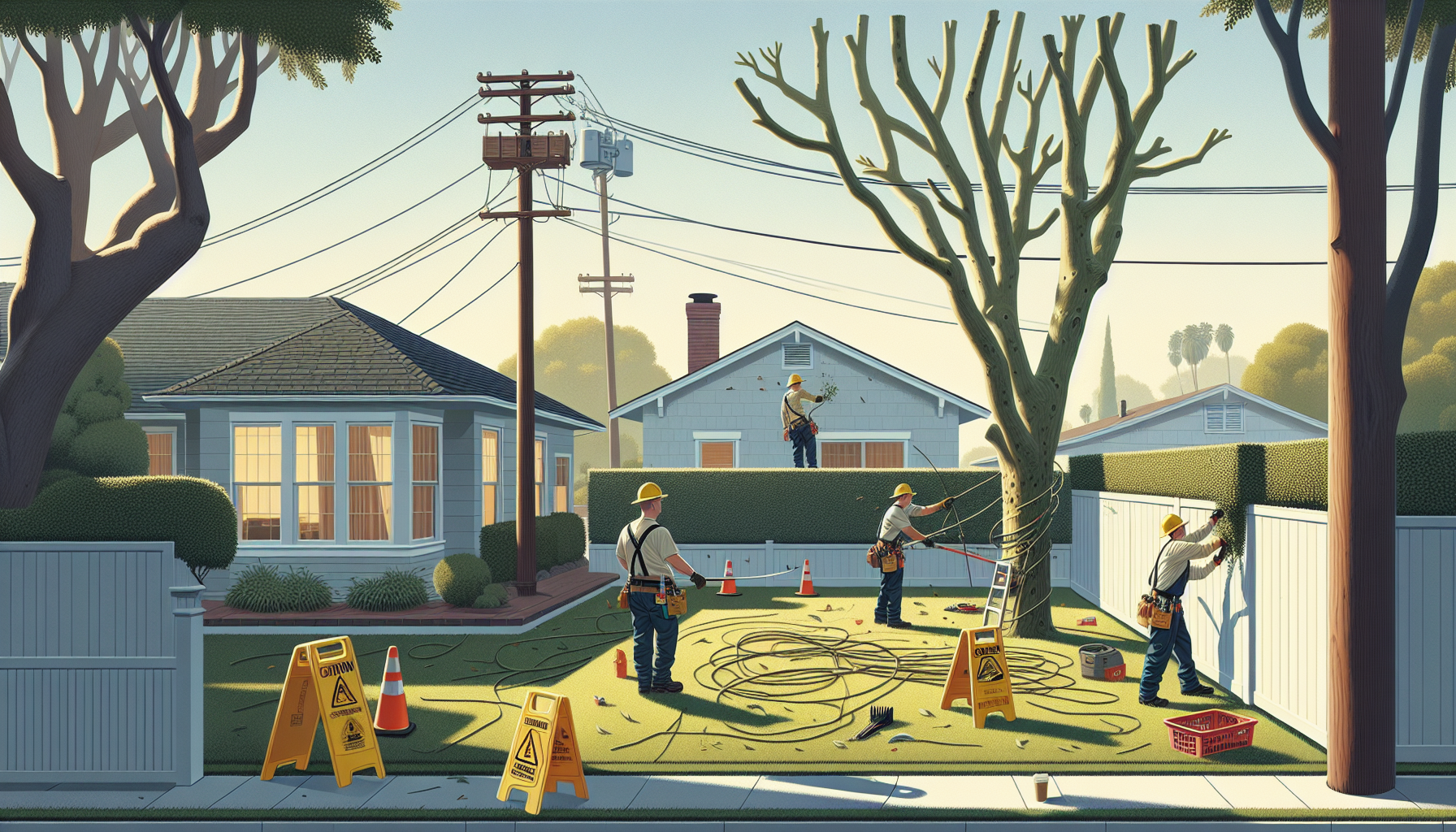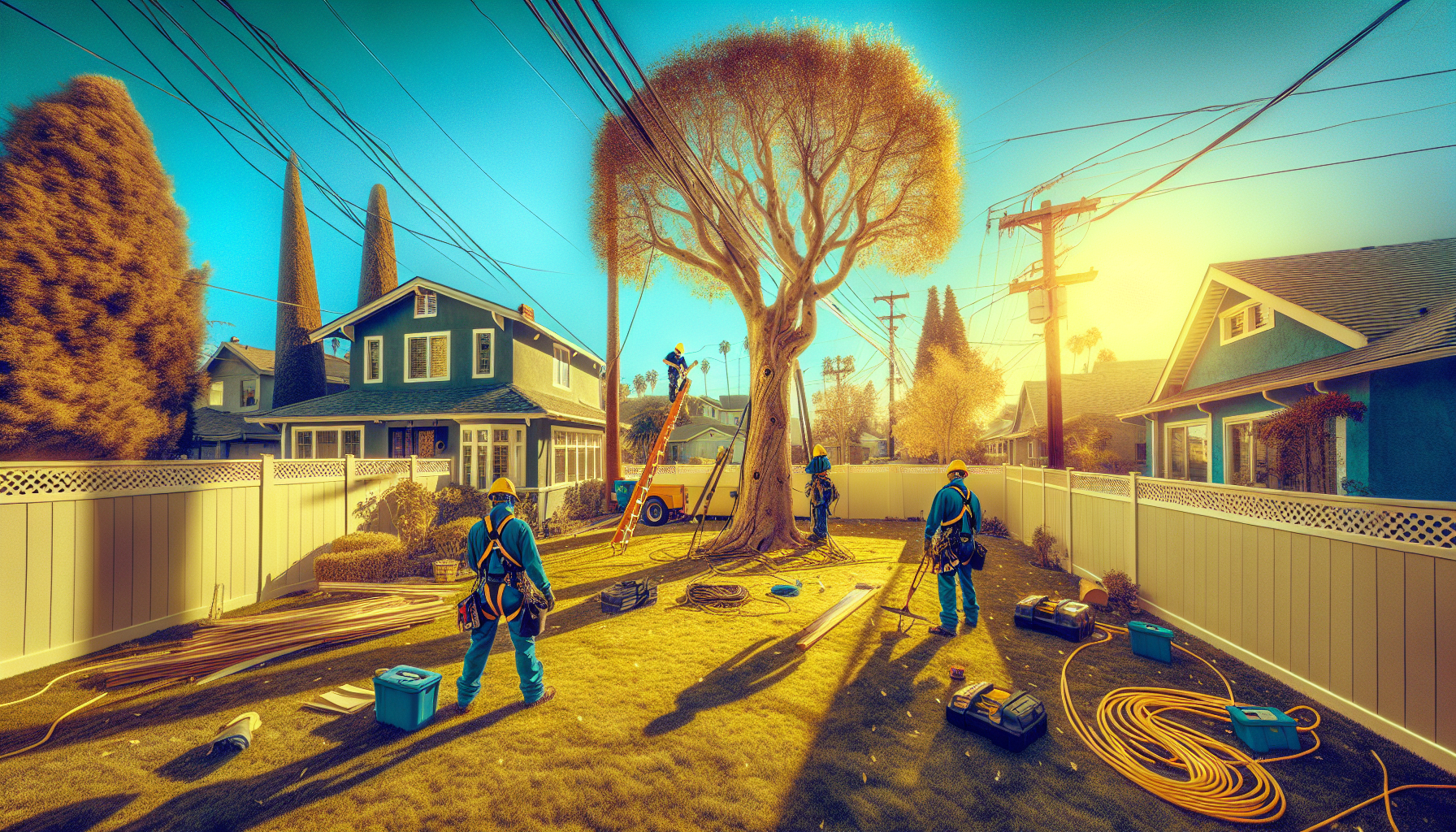
Ensuring a safe environment during outdoor maintenance is crucial, particularly when dealing with tall vegetation near electrical sources.
Understanding the potential electrical hazards is vital, as branches can unintentionally come into contact with utility lines.
Conducting a thorough risk assessment before any work begins helps to identify and mitigate dangers.
High voltages can pose serious threats not only to the crew members but also to nearby buildings and passersby.
Proper precautions, including assessing weather conditions, play a significant role in preventing accidents.
Ultimately, enlisting the help of experienced professionals guarantees that power line clearance is handled with care, significantly reducing the risk of injury or property damage during the trimming process
Understanding Electrical Hazards During Tree Removal
It’s important to recognize the specific electrical hazards that come with tree removal, especially when working close to utility lines. The risks associated with tree felling can lead to serious accidents if not managed well.
Establishing clear regulations related to hazard identification is essential, along with understanding the necessary clearance zones. Proper arborist services involve a careful assessment of the area for both overhead and underground utilities before starting any cutting.
Equipment safety is also vital; malfunctions can happen when operating near electrical sources, increasing the likelihood of mishaps. Conducting thorough site evaluations helps identify possible dangers, ultimately improving job site safety and ensuring a smooth operation from begin to end.
Additionally, having emergency procedures, such as detailed rescue plans and regular safety audits, can greatly lower risks. Workers should undergo safety training that highlights the importance of maintaining safe distances from power lines and wearing the right safety gear. Keeping community guidelines in mind during this process enhances public safety and supports effective tree care within urban forestry.

Importance Of Safety Gear For Tree Felling
Using appropriate safety gear is essential for reducing risks linked to tree felling. Cutting down trees carries various dangers that could lead to serious injuries or fatalities without strict safety measures in place. Proper emergency procedures are crucial for everyone involved, ensuring readiness for unexpected incidents.
Key protective equipment safeguards individuals during chainsaw operations, greatly lowering injury risks. Helmets, protective eyewear, and cut-resistant gloves act as primary defenses against possible threats. Understanding hazard identification helps navigate the workspace while increasing awareness of environmental dangers. Setting up a proper clearance zone reduces exposure to risks and creates a safer work area for all.
Tree Cutting Safety
- Chainsaw operations can cause injuries, such as lacerations or amputations, if safety measures are not observed.
- Wearing protective gear like helmets and cut-resistant gloves can lower the risk of severe injuries by up to 80%.
- Establishing a clearance zone around the work area reduces the chances of accidents and shields workers from falling debris.
- Training in hazard identification is vital as it enables workers to recognize and address potential risks in their surroundings.
Assessing Risks Before Tree Trimming
Recognizing the importance of safety gear and identifying electrical hazards, assessing risks before tree trimming involves a thorough evaluation of the entire environment. Establishing safe distances from nearby structures and utility lines is vital to minimize accidents and ensure a secure working area.
Weather conditions and the overall health of the tree also significantly impact the level of risk involved. Whether it’s a sunny day or stormy weather, understanding how environmental factors affect tree felling is important for maintaining job site safety.
To promote a safer experience, implementing effective safety protocols is crucial. Utilizing personal protective equipment (PPE) serves as a primary safeguard for workers engaged in chainsaw operation, protecting them from potential injuries. Clear communication among the ground crew improves coordination and keeps everyone informed about possible hazards.
Evaluating the need for professional help is another important factor to consider. Choosing arborist services not only provides the expertise needed for effective tree care but also incorporates risk mitigation through contractors who have liability insurance. This can greatly lower the risks associated with trimming operations while ensuring adherence to local regulations.
How To Ensure Power Line Clearance
Based on previous conversations about safety gear and risk assessment, knowing how to keep safe distances from high-voltage lines is crucial for avoiding dangerous situations that can disrupt daily life. Understanding the importance of clearance helps reduce risks linked to overgrown vegetation, which can threaten the integrity of power lines and lead to serious electrical hazards.
Hazards of Vegetation Proximity
When trees come into contact with utility lines, they can create dangerous conditions, resulting in potential power outage prevention issues. Addressing these dangers is essential, especially in areas prone to storm damage where falling branches can impact energy infrastructure.
Site Evaluation and Tree Management
Conducting a thorough site evaluation is vital for identifying tree species that may grow too close to power lines. Knowledge of growth patterns aids in assessing proximity and highlights public safety, particularly in maintenance planning and taking proactive measures.
Establishing Safety Protocols
Creating safety protocols means developing a detailed checklist before starting any work, ensuring adherence to work permits and safety standards regarding tree pruning. This approach not only boosts job site safety but also supports emergency procedures for unforeseen incidents.
Engaging Arborist Services
Utilizing arborist services for tree pruning reinforces adherence to local regulations and significantly lowers the risks posed by overhanging branches. Such collaboration is key for protecting both line workers and the community, making sure that vegetation management is done correctly and safely.
Safe Distances from High-Voltage Lines
- Maintaining a safe distance from high-voltage lines can prevent power outages and enhance public safety.
- Overgrown vegetation, particularly trees, poses a significant risk to power line integrity.
- Regular assessment of tree species and growth patterns helps in proactive risk management.
- Collaboration with professionals for tree pruning ensures compliance with safety standards and reduces hazards.
Role Of Arborist Services In Tree Care
Following the importance of site evaluation and safety protocols, the role of arborist services in tree care is vital for maintaining healthy vegetation. These professionals have specialized knowledge essential for managing and preserving natural resources within our ecosystems and communities.
Arborists conduct thorough site evaluations tailored to the specific needs of various species, ensuring informed decisions regarding maintenance and care.
Certified experts perform comprehensive health assessments to identify potential diseases, pests, or other issues that may threaten tree health.
One of the key services they provide is tree pruning, which encourages growth and resilience, reducing the likelihood of storm damage. Arborists play a significant role in urban forestry, fostering optimal conditions for trees to thrive in city environments.
By following strict safety training protocols, these experts reduce risks during maintenance and removal activities, enhancing job site safety. Engaging skilled professionals for tasks like tree felling not only promotes healthier greenery but also ensures adherence to local regulations, ultimately protecting both the community and line workers.
Following Local Regulations For Tree Removal
Building on the insights about arborist services and site evaluations, effectively managing greenery on your property requires a solid understanding of the legal landscape surrounding tree maintenance and removal practices. Adhering to local regulations is essential for protecting both community health and the environment, as it shapes the way tree care is conducted.
Legal Considerations
Awareness of laws concerning tree roots can help reduce risks, preventing unexpected penalties and ensuring that you manage vegetation responsibly. Effective site evaluation prior to any maintenance activity is critical for identifying potential hazards, ensuring that your practices align with proper storm preparedness and don’t compromise safety protocols.
Engaging Certified Professionals
Hiring certified professionals not only enhances job site safety but also supports compliance with established community guidelines, leading to effective risk mitigation. These experts are equipped to conduct visual inspections and implement protective measures that safeguard both tree health and the surrounding environment. They help keep a keen eye on the clearance zone, ensuring that trees don’t interfere with utility lines, which could heighten risks of electrical hazards.
Managing Greenery
- Understanding local regulations can prevent costly fines associated with improper tree maintenance.
- Tree roots can cause significant damage to nearby structures if not properly managed.
- Utilizing certified professionals can reduce the risk of accidents during tree removal or maintenance.
- Proper storm preparedness can mitigate damage to property and enhance community safety.
Effective Emergency Procedures For Utility Lines
Addressing emergencies involving utility lines is crucial for preventing serious consequences. Quick action when facing incidents related to energy infrastructure is vital for ensuring the safety of both individuals and property.
The threats associated with utility lines, such as electrical hazards and gas leaks, highlight the need for a proactive safety approach. Regular visual inspections around your property support hazard identification and enable early detection of any potential issues.
Awareness of risks like downed lines or unusual odors is key for personal safety. When encountering an issue, prioritizing protective measures can greatly enhance your well-being. Prompt notification of local utility providers is essential in risk mitigation, ensuring any problems are addressed quickly and safely.
Emergency procedures should include clear communication with a ground crew and the establishment of effective rescue plans. This ensures that everyone involved understands their role in maintaining job site safety. Working with trained professionals during tree pruning or maintenance near utility lines is crucial, as they have the necessary safety gear and expertise to handle potential hazards effectively. This coordinated effort not only protects tree health but also helps avoid disruptions of power line clearance in your area.
Implementing Safe Distances From Electrical Infrastructure
Establishing secure distances from electrical infrastructure is crucial for safety. Working around high-voltage areas poses significant risks, which underscores the need for following strict safety protocols to protect both workers and the public.
Local regulations outline the required distances, ensuring the safety of line workers and the community. Before beginning any project, conducting a thorough site evaluation is essential. This assessment plays a vital role in identifying potential hazards and informs the development of effective rescue plans tailored to specific scenarios.
Additionally, adhering to community guidelines raises awareness about the importance of maintaining appropriate distances, which ultimately lowers the risks associated with tree felling and vegetation management. Proper training in safety procedures ensures that all personnel recognize the potential dangers, such as electrical hazards, and the necessity of having suitable safety gear available.
Effective hazard identification and regular visual inspections around work sites are crucial to reduce risks during tasks like tree pruning or trimming near utility lines. This proactive approach enhances job site safety and underscores the importance of power line clearance to avoid accidents. As part of a coordinated safety effort, maintaining clear communication with the ground crew during operations ensures that everyone understands their roles, ultimately enhancing public safety. Implementing these measures supports overall storm preparedness, fostering a secure environment for workers while safeguarding tree health in urban forestry contexts.
The Benefits of Hiring a Professional Tree Removal Service for Your Property
Is It Safe to Stay Home During Tree Removal What You Need to Consider
